This feature is part two of our November 2019 cover story, ‘The Borderlands: Dispatches from the Edge of China.’ To read more interesting stories from the edge of China, click here.
The People’s Republic of China and Democratic People’s Republic of Korea’s diplomatic history dates back to October 1949, when the two newly founded republics established diplomatic relations. Roughly a year later, China would come to the aid of the DPRK during the War to Resist US Aggression and Aid Korea, a conflict more commonly referred to in the West as the Korean War.
Today, the PRC and the DPRK are two of five self-proclaimed communist states still in existence, and still, in 2019, relics of the conflict dot the two nations’ 1,416-kilometer border.
Perhaps nowhere is this more apparent than in Dandong, a city of well over two million people that lies directly across the Yalu River from the Korean city of Sinuiju. Along the waterfront in Dandong, the famous Yalu River Broken Bridge (wrecked as a result of US bombing in February of 1951) stands as a stark reminder of the two countries’ forged-in-blood relationship.
The Broken Bridge itself is something of a tourist attraction these days, with visitors from across China and Asia at large coming to gawk at the 108-year-old structure, which was built by the Empire of Japan, and catch a glimpse of life on the other side of the Yalu in the DPRK. Tourists can also check out a number of Korean War-era anti-aircraft guns, along with a monument to Peng Dehuai, the Chinese general who led the People’s Volunteer Army – the Chinese force that fought to aid Korea.
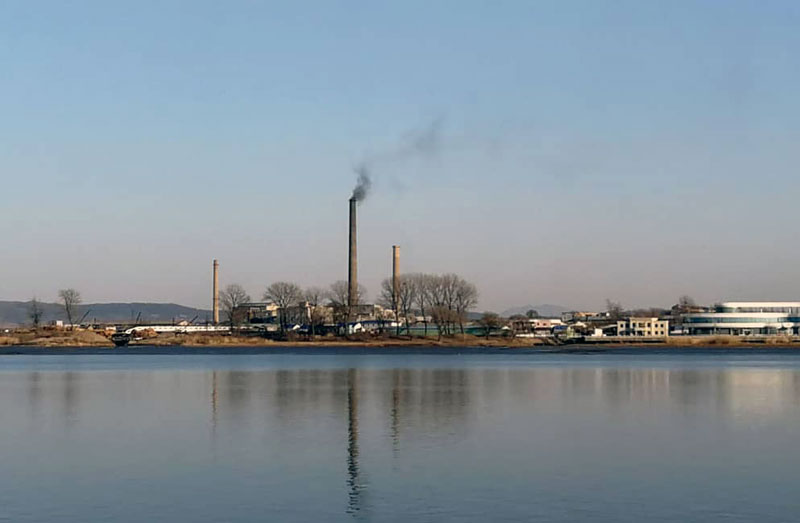
Sinuiju, Democratic People’s Republic of Korea. Image by Matthew Bossons/That’s
When I visit the bridge on a crisp and clear March afternoon, Sinuiju appears frozen in time. The city’s iconic, unmoving Ferris wheel is visible from the viewing station at the bridge’s abrupt, broken end, as is a giant, circular concrete structure that experts are speculating may one day be a hotel. A man rides along the Sinuiju riverfront on a bicycle, but aside from him, I see no other signs of life. There is, however, much more action on the Chinese side of the Yalu.
Situated roughly 100 meters upstream from the Broken Bridge is the Sino-Korean Friendship Bridge, which accommodates trains and vehicles traveling between the two nations. According to Simon Cockerell, the general manager and a tour leader at Koryo Tours – a leading North Korea travel company – this is the most popular crossing for tourists traveling overland into the DPRK. (Other crossings between China and North Korea do exist, while there is a single rail crossing between Russia and the DPRK.)
READ MORE: 120 Chinese Tourists Cross Frozen River to North Korea to Celebrate New Year
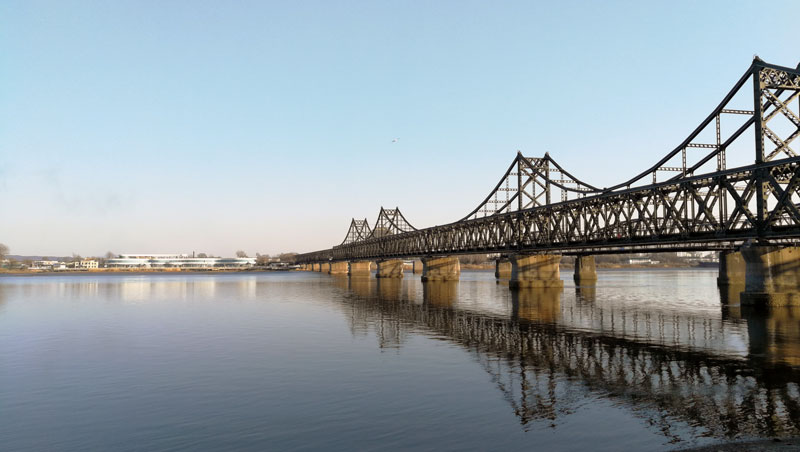
The Sino-Korean Friendship Bridge linking Dandong to Sinuiju. Image by Matthew Bossons/That’s
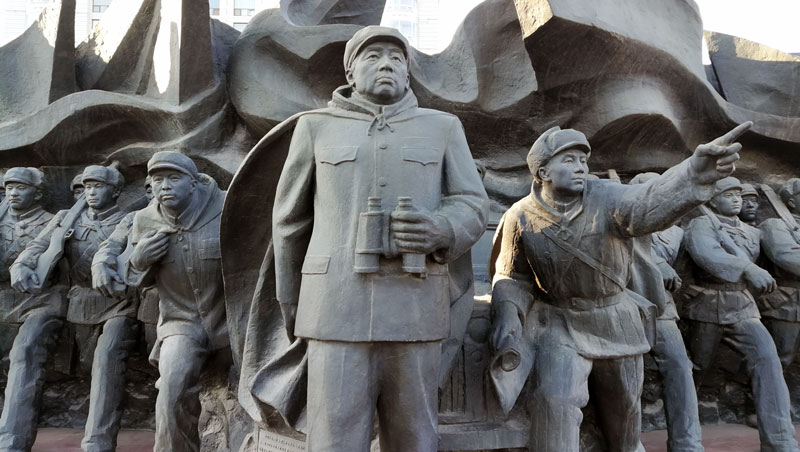
A monument to Peng Dehuai, the Chinese general who led the People’s Volunteer Army – the Chinese force that fought to aid Korea. Image by Matthew Bossons/That’s
Next to the bridges, hawkers sell Korean trinkets, from Kim Il-sung and Kim Jong-il pins and DPRK currency, to Korean cigarettes and booze, and slow boats depart from a dock to cruise the marine border between the two countries.
Along the road that runs the length of Dandong’s riverfront, and on the roads immediately behind it, are a myriad of shops selling imported Korean goods, as well as a number of restaurants specializing in food from both the northern and southern portions of the Korean peninsula.
One of these restaurants is particularly conspicuous. The windows are blacked out with heavy curtains, and the only view inside from Binhai Gong Lu (which runs parallel to the Yalu River) is through the establishment’s small rotating glass door.
When my wife and I enter the eatery for dinner we are immediately greeted by a tall, strikingly beautiful Korean woman proudly adorned with a DPRK flag pin. Inside the mostly empty restaurant, television screens play news programming from south of Dandong, with Marshal Kim Jong-un featured prominently in much of the reporting.
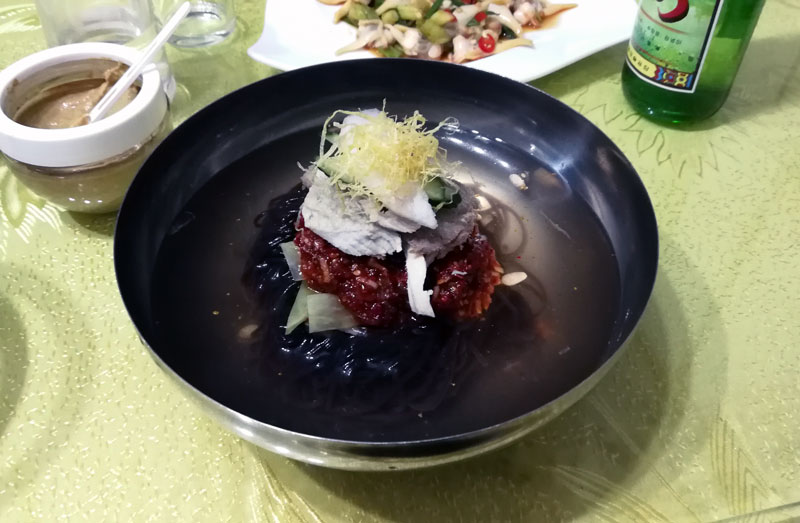
Pyongyang cold noodles at a restaurant in Dandong. Image by Matthew Bossons/That’s
The menu features a mishmash of Korean fare; bibimbap, kimbap, kimchi and the famous ‘Pyongyang cold noodles,’ and dishes arrive quickly. Prices are reasonable and service is much friendlier than I’d been led to believe it would be for a Westerner. The staffers, one in particular, are also extremely inquisitive, asking questions about my home country and 2-year-old daughter. Even marriage came up in conversation.
“Are foreign men nice – do they make good husbands?” our waitress asks my wife in Chinese. After explaining, in cliche form, that good and bad folks reside just about everywhere, my wife asks the server, who appears to be in her early 20s, if she can marry someone from outside her country. She silently shakes her head and our conversation comes to a close. I pay the bill and we head into the night.
“There is simply the end of one country, a river, then the start of the other”
A post-dinner walk along the riverside promenade lays bare the major difference in development and infrastructure between Dandong and Sinuiju. The Chinese side of the Yalu is brightly lit up, with restaurant signage, hotel lights and a steady flow of vehicle and human traffic. On the Korean side: complete and total blackness.
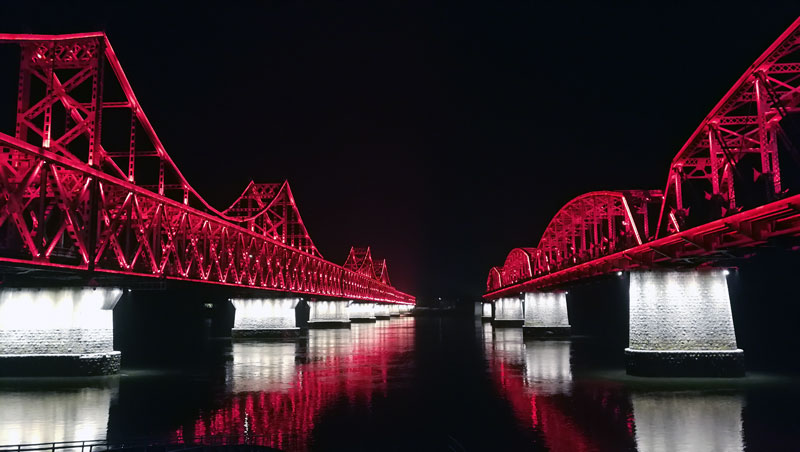
Looking towards Sinuiju at night. Image by Matthew Bossons/That’s
The following day, a hired car takes me along the border and out of the city. We pass a section of the Great Wall, followed by long stretches of metal fencing crowned with barbwire. Occasionally, signage informs people on the Chinese side of the border to refrain from interacting with folks on the other side of the line.
After driving for about half an hour, my driver stops to purchase cigarettes at a small house-cum-shop located directly across from the border. I take the chance to ask the smoke salesman about his interactions with DPRK residents at the border fence.
“I don’t really see people coming to the fence from the Korean side very often anymore. In decades past, Korean people – including military personnel – would sometimes come to the fence to trade and sell stuff,” the shopkeeper tells me. “Chinese people would sometimes cross over the fence into Korea to purchase goods. But not anymore; security is much tighter these days.”
READ MORE: I Hitchhiked Along the North Korean Border
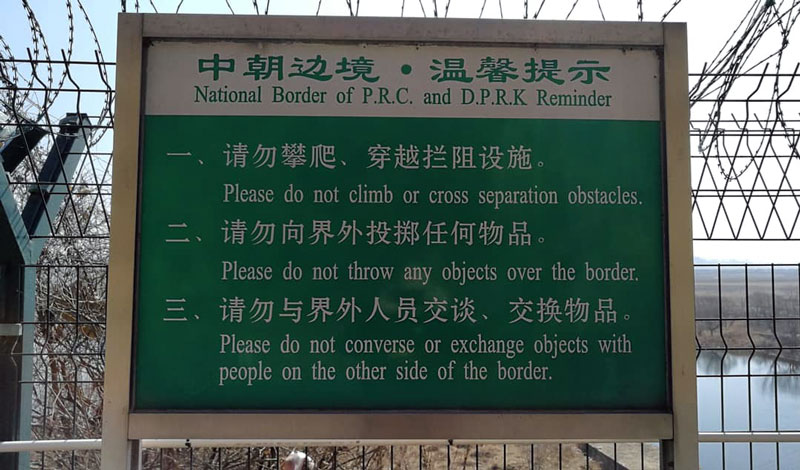
A sign informing people on the Chinese side of the border to refrain from interacting with folks on the other side of the line. Image by Matthew Bossons/That’s
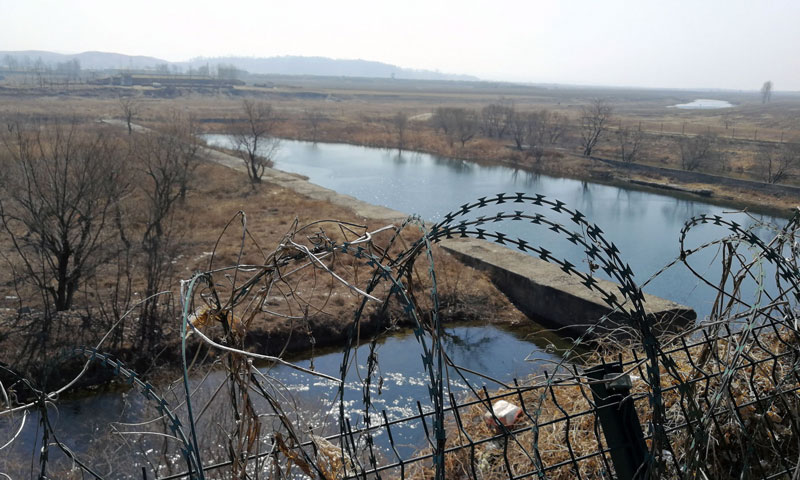
The countryside outside of Sinuiju, as seen from the PRC. Image by Matthew Bossons/That’s
Another 20 or so minutes from the shopkeeper’s abode and we arrive at a ferry dock, where boats regularly depart to cruise the rural Korean shoreline – away from the relative development of Sinuiju. We board one of the vessels and huddle on the top deck alongside a mishmash of Chinese and Japanese tourists.
The choppy boat ride – which some have fairly argued qualifies as a human safari – takes us distressingly close to the DPRK, at times coming within a couple of hundred meters of small villages and pastel-blue watchtowers. People too are visible, walking and biking along the small road that crosses the hilly terrain and connects the rustic settlements that line the Yalu River.

A small settlement outside of Sinuiju. Image by Matthew Bossons/That’s
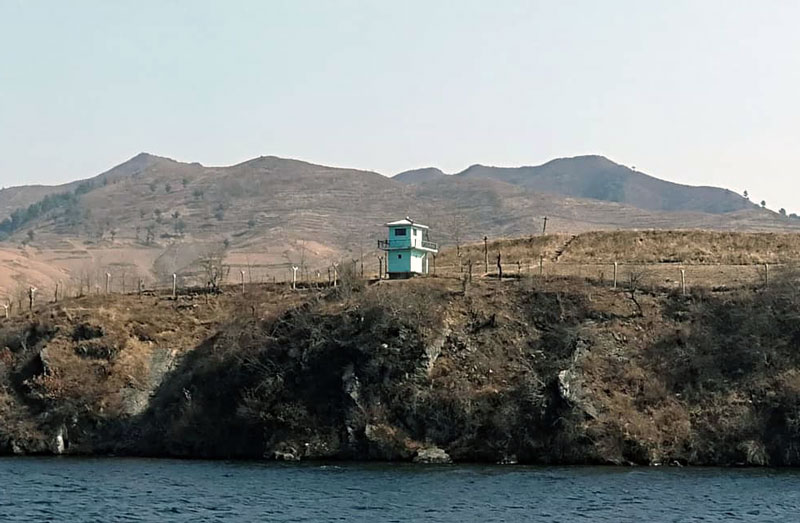
A North Korean watchtower, as seen from a Chinese boat on the Yalu River. Image by Matthew Bossons/That’s
While already common knowledge, the boat ride confirms that life on the North Korean side of the border is vastly different from the PRC.
“[The DPRK and PRC] are completely different, frankly. There is not the kind of fade and gradual merging that defines the borders in most other places,” says Cockerell. “There is simply the end of one country, a river, then the start of the other.”
Enjoy this story? Click here to read more features from our November 2019 cover story, ‘The Borderlands: Dispatches from the Edge of China.’
[Cover image by Matthew Bossons/That’s]
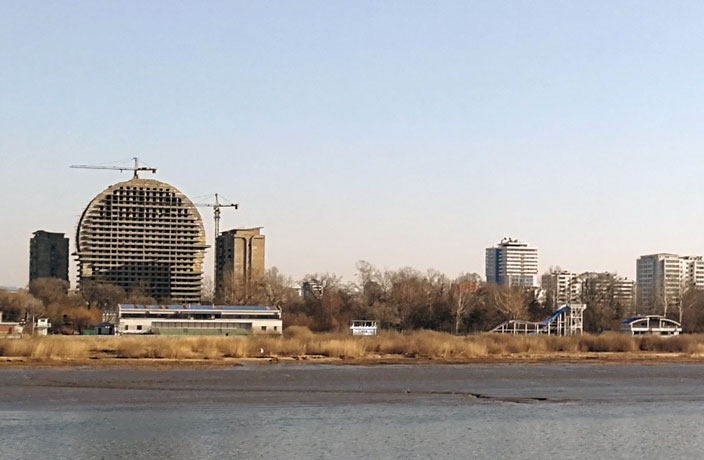






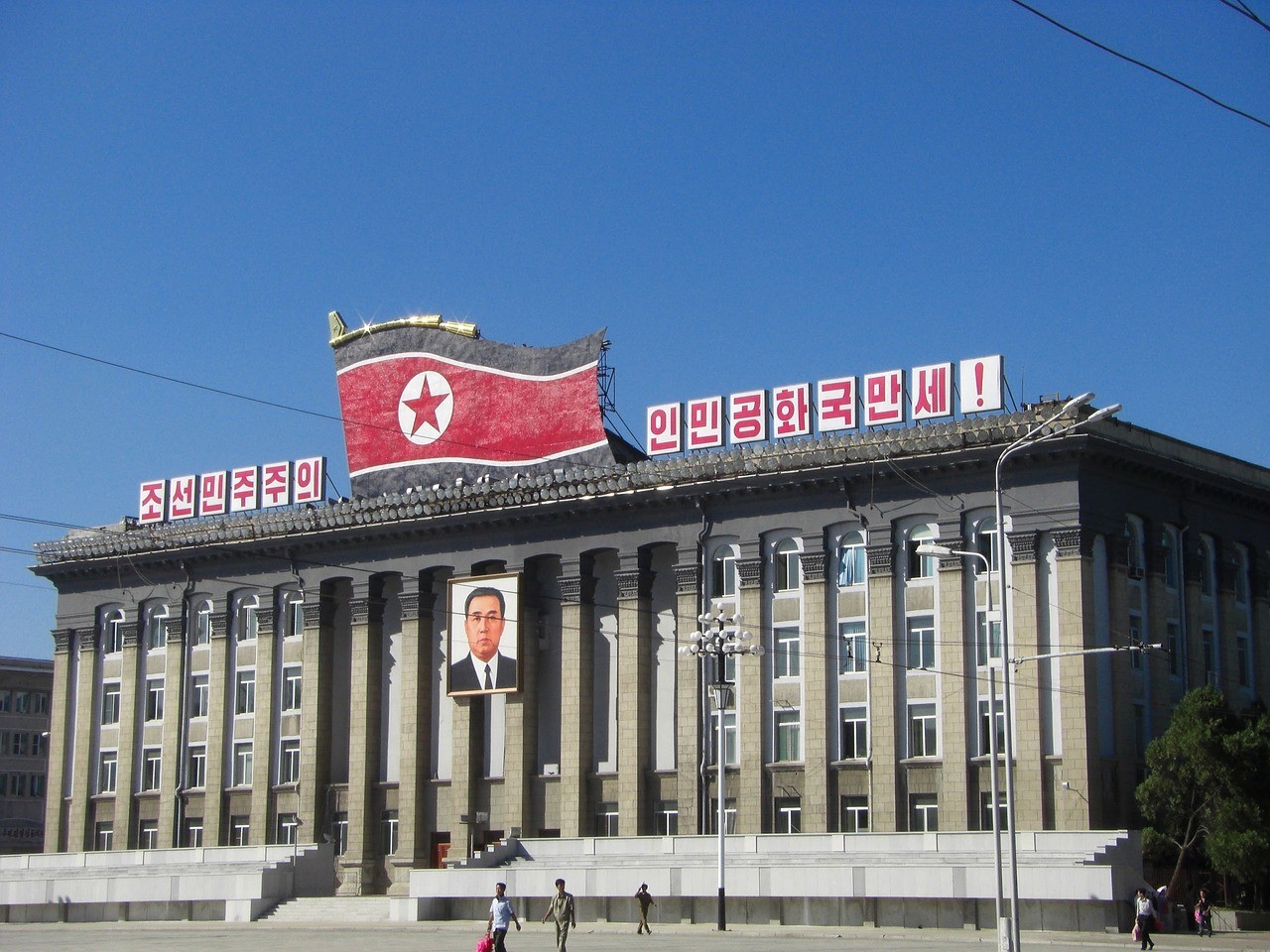














0 User Comments